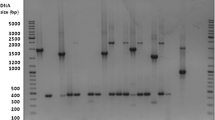Abstract
Diplorickettsia massiliensis has been recently isolated from Ixodes ricinus ticks. We screened 13,872 serum samples from patients in France with suspected tick-borne diseases and found three cases that had serological evidence of D. massiliensis infection; for one of these three cases, we obtained molecular evidence of an infection as well.


Similar content being viewed by others
References
Mediannikov O, Sekeyová Z, Birg ML, Raoult D (2010) A novel obligate intracellular gamma-proteobacterium associated with ixodid ticks, Diplorickettsia massiliensis, Gen. Nov., Sp. Nov. PLoS One 5:e11478
Parola P, Raoult D (2001) Ticks and tickborne bacterial diseases in humans: an emerging infectious threat. Clin Infect Dis 32:897–928
Jado I, Oteo JA, Aldámiz M, Gil H, Escudero R, Ibarra V, Portu J, Portillo A, Lezaun MJ, García-Amil C, Rodríguez-Moreno I, Anda P (2007) Rickettsia monacensis and human disease, Spain. Emerg Infect Dis 13(9):1405–1407
Raoult D, Dasch GA (1989) Line blot and western blot immunoassays for diagnosis of Mediterranean spotted fever. J Clin Microbiol 27:2073–2079
James AM, Liveris D, Wormser GP, Schwartz I, Montecalvo MA, Johnson BJ (2001) Borrelia lonestari infection after a bite by an Amblyomma americanum tick. J Infect Dis 183:1810–1814
Buller RS, Arens M, Hmiel SP, Paddock CD, Sumner JW, Rikhisa Y, Unver A, Gaudreault-Keener M, Manian FA, Liddell AM, Schmulewitz N, Storch GA (1999) Ehrlichia ewingii, a newly recognized agent of human ehrlichiosis. N Engl J Med 341:148–155
Maeda K, Markowitz N, Hawley RC, Ristic M, Cox D, McDade JE (1987) Human infection with Ehrlichia canis, a leukocytic rickettsia. N Engl J Med 316:853–856
Bakken JS, Krueth J, Wilson-Nordskog C, Tilden RL, Asanovich K, Dumler JS (1996) Clinical and laboratory characteristics of human granulocytic ehrlichiosis. JAMA 275:199–205
Carpenter CF, Gandhi TK, Kong LK, Corey GR, Chen SM, Walker DH, Dumler JS, Breitschwerdt E, Hegarty B, Sexton DJ (1999) The incidence of ehrlichial and rickettsial infection in patients with unexplained fever and recent history of tick bite in central North Carolina. J Infect Dis 180:900–903
Belongia EA, Reed KD, Mitchell PD, Mueller-Rizner N, Vandermause M, Finkel MF, Kazmierczak JJ (2001) Tickborne infections as a cause of nonspecific febrile illness in Wisconsin. Clin Infect Dis 32:1434–1439
Lotric-Furlan S, Petrovec M, Avsic-Zupanc T, Nicholson WL, Sumner JW, Childs JE, Strle F (2001) Prospective assessment of the etiology of acute febrile illness after a tick bite in Slovenia. Clin Infect Dis 33:503–510
Parola P, Rovery C, Rolain JM, Brouqui P, Davoust B, Raoult D (2009) Rickettsia slovaca and R. raoultii in tick-borne Rickettsioses. Emerg Infect Dis 15:1105–1108
Fournier PE, Grunnenberger F, Jaulhac B, Gastinger G, Raoult D (2000) Evidence of Rickettsia helvetica infection in humans, eastern France. Emerg Infect Dis 6:389–392
Raoult D, Brouqui P, Roux V (1996) A new spotted-fever-group rickettsiosis. Lancet 348:412
Acknowledgments
The authors thank Malgorzata Kowalczewska for the helpful technical assistance. Geetha Subramanian is a receiver of a stipend from APHM (Assistance Publique—Hôpitaux de Marseille). No funding of any kind has been received and all data have been generated as part of the routine work at URMITE, UMR CNRS 6236—IRD198. We declare that we have no competing interests.
Conflict of interest
None.
Author information
Authors and Affiliations
Corresponding author
Rights and permissions
About this article
Cite this article
Subramanian, G., Mediannikov, O., Angelakis, E. et al. Diplorickettsia massiliensis as a human pathogen. Eur J Clin Microbiol Infect Dis 31, 365–369 (2012). https://doi.org/10.1007/s10096-011-1318-7
Received:
Accepted:
Published:
Issue Date:
DOI: https://doi.org/10.1007/s10096-011-1318-7




